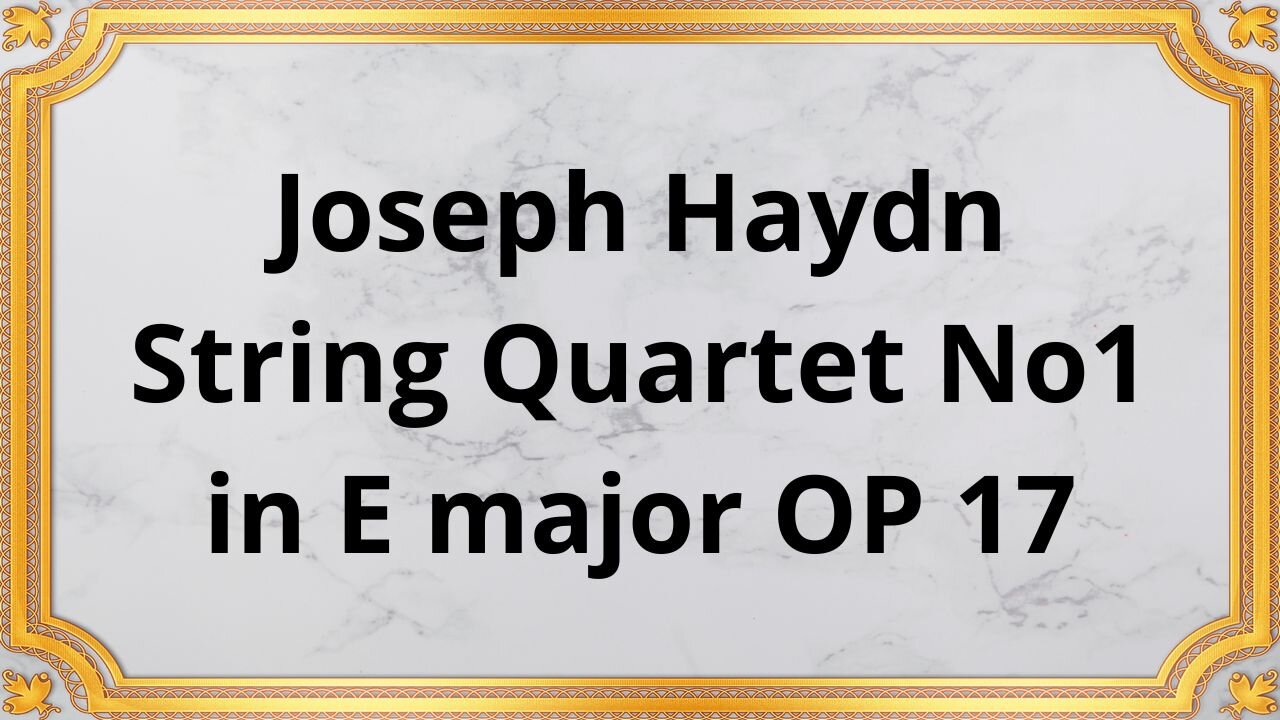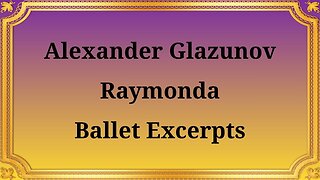Premium Only Content

Joseph Haydn String Quartet No 1 in E major OP 17
#JosephHaydn #StringQuartets #ClassicalMusic #MusicalComposition #ChamberMusic #EMajor #OP17 #ClassicalComposer #ClassicalEra
JOSEPH HAYDN COMPLETE STRING QUARTETS OF OP17
Publication date 1951
SCHNEIDER QUARTET
Alexander Schneider, First Violin
Isidore Cohen, Second Violin
Karen Tuttle, viola
Madeline Foley, violoncello
Joseph Haydn, one of the most influential composers of the classical era, left an enduring legacy through his remarkable compositions. Among his extensive catalog, the String Quartet No. 1 in E major, Op. 17, stands as a musical masterpiece.
Written in the late 1770s, Haydn's String Quartet No. 1 in E major emerged during a period of significant musical transformation. The classical era witnessed a departure from the ornate and complex Baroque style, favoring a more balanced and elegant approach. Haydn, often referred to as the "Father of the String Quartet," played a crucial role in shaping this genre. His Op. 17 quartet exemplifies the musical innovation and artistic prowess of the time.
Haydn's String Quartet No. 1 comprises four movements, adhering to the traditional structure of a classical string quartet. The first movement, marked Allegro moderato, introduces the listener to a lively and spirited theme, showcasing Haydn's ability to create captivating melodies and intricate harmonies. The second movement, Adagio, offers a contrasting mood, providing a serene and introspective respite. The third movement, Menuetto, presents a graceful and rhythmic dance-like character, while the final movement, Presto, captivates with its energetic and exhilarating conclusion.
Haydn's mastery of form is evident throughout the quartet. He skillfully weaves together the voices of the two violins, viola, and cello, creating a harmonious dialogue. The quartet showcases Haydn's command of thematic development, as motifs are introduced, transformed, and interwoven, creating a sense of unity and coherence.
Haydn's String Quartet No. 1 in E major evokes a range of emotions in its listeners. The opening Allegro moderato immediately grabs attention with its joyful and vibrant character, setting the stage for an engaging musical journey. The Adagio movement, with its tender and introspective melodies, invites contemplation and introspection. The Menuetto movement, with its dance-like quality, brings a sense of elegance and grace. Finally, the Presto movement, with its energetic and spirited nature, leaves the listener exhilarated and fulfilled.
The String Quartet No. 1 in E major, Op. 17, holds a significant place in the chamber music repertoire. Haydn's meticulous craftsmanship, inventive melodies, and harmonic richness have ensured its enduring legacy. Moreover, this quartet served as a foundation for future composers, including Mozart and Beethoven, who expanded upon Haydn's innovations, pushing the boundaries of the genre.
Conclusion:
Joseph Haydn's String Quartet No. 1 in E major, Op. 17, represents a pinnacle of musical artistry and innovation. Its historical context, structural elements, and emotional impact all contribute to its enduring significance. Through this quartet, Haydn showcases his mastery of form, his ability to evoke a range of emotions, and his profound influence on the development of chamber music. As we immerse ourselves in the beauty of this composition, we gain a deeper appreciation for Haydn's genius and his lasting impact on the world of classical music.
You have the opportunity to support the channel:
https://destream.net/live/RadSiarAl/donate
https://www.buymeacoffee.com/6355radsiaral
-
 52:11
52:11
Classical music_Music Inspiration
30 days agoAlexandra Glazunov Excerpts from the ballet "Raymonda"
961 -
 18:03
18:03
Nikko Ortiz
1 day agoEBT Meltdowns Are Insane...
10.9K30 -
 17:33
17:33
a12cat34dog
22 hours agoRUMBLE TAKEOVER @ DREAMHACK | VLOG | {HALLOWEEN 2025}
47.1K25 -
 10:48
10:48
GritsGG
15 hours agoWarzone Stadium Easter Egg! Unlock Grau Blueprint EASY!
16.9K2 -
 LIVE
LIVE
Lofi Girl
3 years agolofi hip hop radio 📚 - beats to relax/study to
545 watching -
 1:43:54
1:43:54
TruthStream with Joe and Scott
3 days agoStuey and Elisa V interview Joe and Scott Q, AI, Glutathione, Tylenol etc 11/5 #510
18.7K6 -
 29:15
29:15
BlabberingCollector
2 days agoHarry Potter X Fortnite, Fans Reee Over Trans Rights, NEW Audiobooks Are OUT, Wizarding Quick Hits
34.8K4 -
 1:20:42
1:20:42
The Connect: With Johnny Mitchell
6 days ago $13.66 earnedThe Truth Behind The U.S. Invasion Of Venezuela: Ed Calderon Exposes American Regime Change Secrets
44.5K26 -
 2:10:18
2:10:18
FreshandFit
8 hours agoAfter Hours w/ Girls
136K36 -
 2:06:29
2:06:29
TimcastIRL
14 hours agoAirlines Cancel Over 700 Flights, Travel APOCALYPSE Is Now, Trump Says END FILIBUSTER | Timcast IRL
240K121